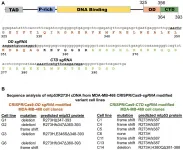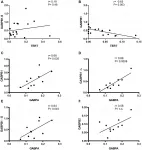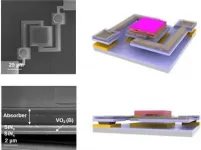(Press-News.org) PITTSBURGH, July 26, 2021 - Adolescents who set goals for their future and those with strong parental support are less likely to use e-cigarettes and other tobacco products, according to a study by UPMC Children's Hospital of Pittsburgh and University of Pittsburgh School of Medicine physician-scientists.
The research, published today in the journal Pediatrics, suggests that strategies to prevent youth vaping may be different from what works to dissuade youth from smoking cigarettes.
"The use of e-cigarettes by young people is at epidemic proportions, with 27% of youth surveyed saying they'd vaped in the last 30 days," said lead author Nicholas Szoko, M.D., a fellow in the Division of Adolescent and Young Adult Medicine at UPMC Children's. "And a lot of the traditional methods we think of for counseling youth on the dangers of tobacco and drug use may not apply to vaping. Pediatricians and parents need a better understanding of what motivates adolescents to eschew e-cigarettes."
Szoko and his colleagues analyzed anonymous questionnaires administered in partnership with the Allegheny County Health Department and completed by 2,487 high school students in Pittsburgh Public Schools. The surveys asked questions to ascertain if and how often the students used e-cigarettes or other tobacco products, and to determine if any of four "protective factors" validated by previous research were associated with a lower likelihood of vaping or smoking.
The protective factors examined were:
Future orientation: A person's beliefs, hopes and goals related to the future.
Parental monitoring: Parent-child interactions and communication.
Social support: The ability to rely on friends and peers.
School connectedness: A sense of belonging and inclusion at school.
In the study, positive future orientation and high levels of parental monitoring were both linked with a 10% to 25% lower prevalence of recently or ever vaping, compared to peers with lower scores on those protective factors. There was no link between social support or school connectedness and use of e-cigarettes.
All four protective factors were associated with lower prevalence of smoking or use of other tobacco products, but none were linked to intent to quit using tobacco products. This suggests that once young people begin to use tobacco, quitting may be more difficult to promote. The researchers note that these findings should be explored to develop improved youth tobacco prevention efforts, but that it isn't surprising that the results for vaping weren't exactly the same as for smoking.
"E-cigarettes are positioned and marketed differently than tobacco cigarettes. They've been popularized as tools for smoking cessation, and previous research has found the various flavors and trendy ads for vaping are attractive to youth," said Szoko. "We also know that vaping primes adolescents to transition to smoking cigarettes and other substance use. So, it stands to reason that we may need different approaches to keep kids from vaping, than we use to stop them from smoking."
Senior author Alison Culyba, M.D., Ph.D., M.P.H., assistant professor of pediatrics, public health, and clinical and translational science at Pitt, noted that frameworks already exist to help clinicians use future orientation and encourage parental monitoring when providing health care to young people, which bodes well for developing e-cigarette intervention programs to strengthen these protective factors.
"Future orientation is something very tangible that pediatricians and other health care providers can talk with teens about in the clinic--motivational interviewing is something we're very comfortable doing with our patients," said Culyba, also an adolescent medicine physician and director of the Empowering Teens to Thrive program at UPMC Children's. "And we can help parents to navigate their roles as their children become pre-teens and teens, and help encourage open conversations with their kids about what they're encountering."
INFORMATION:
Additional authors on this research are Maya I. Ragavan, M.D., Susheel K. Khetarpal, and Kar-Hai Chu, Ph.D., all of Pitt or UPMC, or both.
This research was supported by The Heinz Endowments, The Grable Foundation and National Institutes of Health grants KL2TR001856, UL1TR001857, K23HD098277-01.
To read this release online or share it, visit http://www.upmc.com/media/news/072621-Szoko-Vape-Protective-Pediatrics [when embargo lifts].
About UPMC Children's Hospital of Pittsburgh
Regionally, nationally, and globally, UPMC Children's Hospital of Pittsburgh is a leader in the treatment of childhood conditions and diseases, a pioneer in the development of new and improved therapies, and a top educator of the next generation of pediatricians and pediatric subspecialists. With generous community support, UPMC Children's Hospital has fulfilled this mission since its founding in 1890. UPMC Children's is recognized consistently for its clinical, research, educational, and advocacy-related accomplishments, including ranking in the top 10 on the 2021-2022 U.S. News Honor Roll of America's Best Children's Hospitals. UPMC Children's also ranks 15th among children's hospitals and schools of medicine in funding for pediatric research provided by the National Institutes of Health (FY2019).
About the University of Pittsburgh School of Medicine
As one of the nation's leading academic centers for biomedical research, the University of Pittsburgh School of Medicine integrates advanced technology with basic science across a broad range of disciplines in a continuous quest to harness the power of new knowledge and improve the human condition. Driven mainly by the School of Medicine and its affiliates, Pitt has ranked among the top 10 recipients of funding from the National Institutes of Health since 1998. In rankings recently released by the National Science Foundation, Pitt ranked fifth among all American universities in total federal science and engineering research and development support.
Likewise, the School of Medicine is equally committed to advancing the quality and strength of its medical and graduate education programs, for which it is recognized as an innovative leader, and to training highly skilled, compassionate clinicians and creative scientists well-equipped to engage in world-class research. The School of Medicine is the academic partner of UPMC, which has collaborated with the University to raise the standard of medical excellence in Pittsburgh and to position health care as a driving force behind the region's economy. For more information about the School of Medicine, see http://www.medschool.pitt.edu.
http://www.upmc.com/media
Survival rates for adolescents and young adults diagnosed with cancer have varied considerably depending on cancer type. A new study indicates that survival for multiple cancer types in such patients has improved in recent years, but some patients diagnosed with common cancer types still show limited survival improvements. The results are published by Wiley early online in CANCER, a peer-reviewed journal of the American Cancer Society.
For the study, investigators at the National Cancer Institute analyzed survival trends related to cancers with the highest mortality rates in adolescents and young adults. Relying on information from the Surveillance, Epidemiology, and End Results (SEER) cancer ...
Oncotarget published "Frame-shift mediated reduction of gain-of-function p53 R273H and deletion of the R273H C-terminus in breast cancer cells result in replication-stress sensitivity" which reported that these authors recently documented that gain-of-function mutant p53 R273H in triple negative breast cancer cells interacts with replicating DNA and PARP1. The missense R273H GOF mtp53 has a mutated central DNA binding domain that renders it unable to bind specifically to DNA, but maintains the capacity to interact tightly with chromatin.
Both the C-terminal domain ...
Oncotarget published "TERT and its binding protein: overexpression of GABPA/B in high grade gliomas" which reported that all GA-binding proteins progress through the glioma grades and have the highest expression levels in secondary glioblastomas.
In secondary glioblastomas after chemotherapy, GABPB1 and GABPB1-L are expressed on a lower level than without treatment.
Between primary and secondary glioblastomas with and without chemotherapy, TERT is elevated in the former while GABPB1 is increased in the secondary glioblastomas.
GABPA and GABPB1, GABPB1-L and GABPB1-S positively correlate in primary glioblastomas.
This ...
Thermal-imaging sensors that detect and capture images of the heat signatures of human bodies and other objects have recently sprung into use in thermostats to check facial temperatures in a contactless attempt to screen for COVID-19 at several building entrances. Under these circumstances, the smartphone industry is actively considering the incorporation of such sensors as portable features to create the add-on function of measuring temperature in real time. Additionally, the application of such technology to autonomous vehicles may facilitate safer autonomous driving.
A research team lead by Dr. ...
The feeling of a needle piercing skin is familiar to most people, especially recently as COVID-19 vaccinations gain momentum. But what exactly happens when a needle punctures skin? The answer is revealed in a new paper published recently in the Journal of the Mechanics and Physics of Solids. ...
Even in the absence of bark beetle outbreaks and wildfire, trees in Colorado subalpine forests are dying at increasing rates from warmer and drier summer conditions, found recent University of Colorado Boulder research.
The study, published in the May print issue of the Journal of Ecology, also found that this trend is increasing. In fact, tree mortality in subalpine Colorado forests not affected by fire or bark beetle outbreaks in the last decade has more than tripled since the 1980s.
"We have bark beetle outbreaks and wildfires that cause very obvious mortality of trees in Colorado. But we're showing that even in the areas that people go hiking in and where the forest looks healthy, mortality is increasing ...
AMES, Iowa - A new study led by an Iowa State University scientist sheds light on how organisms have evolved to address imbalances in sex chromosomes.
The study looks at a species of softshell turtle, but the results could help to illuminate an important evolutionary process in many species, said Nicole Valenzuela, professor of ecology, evolution and organismal biology and lead author of the study.
Many organisms determine their sex by a pair of specialized chromosomes that appear in virtually every cell of an organism's body. A matched pair of chromosomes results in one sex, while a mismatched pair results in another sex. For instance, in humans and many other species, sex chromosomes are referred to as X and Y. Typically, two X chromosomes ...
Tokyo, Japan - Researchers from Tokyo Metropolitan University have developed a new technology which allows non-contact manipulation of small objects using sound waves. They used a hemispherical array of ultrasound transducers to generate a 3D acoustic fields which stably trapped and lifted a small polystyrene ball from a reflective surface. Although their technique employs a method similar to laser trapping in biology, adaptable to a wider range of particle sizes and materials.
The ability to move objects without touching them might sound like magic, but in the world of ...
At a glance:
Researchers studied cells collected by nasal swabs at the moment of diagnosis for both mild and severe COVID-19 patients
Cells taken from patients who went on to develop severe disease had a muted antiviral response compared to those who went on to develop mild disease
This suggests that it may be possible to develop early interventions that prevent severe COVID-19 from developing
The team also identified infected host cells and pathways associated with protection against infection that may enable new therapeutic strategies for COVID-19 and other respiratory viral infections
CAMBRIDGE, MA (July 23, 2021) -- Over the past 18 ...
St. Jude Children's Research Hospital investigators have demonstrated that comprehensive genomic sequencing of all pediatric cancer patients is feasible and essential to capitalize on the lifesaving potential of precision medicine. Results from the St. Jude Genomes for Kids study appear online today in the journal Cancer Discovery.
Whole genome and whole exome sequencing of germline DNA was offered to all 309 patients who enrolled in the study. Whole genome, whole exome and RNA sequencing of tumor DNA was carried out for the 253 patients for whom adequate tumor samples were available.
Overall, 86% of patients had at least one ...






